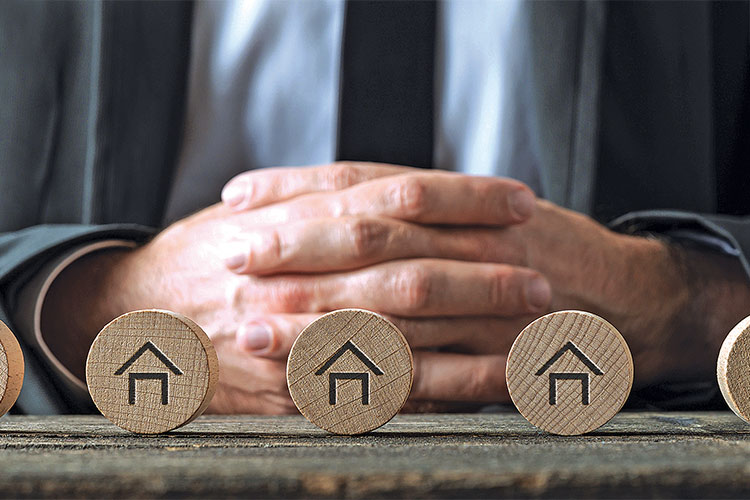Unless there are large fluctuations in the exchange rate and as long as people experience that their standard of living is rising, and while banks guided by the same logic expand their mortgage portfolios, the current trends in the real estate market will continue. The million-dollar question is: when will that connection begin to slip?
Inflation, the possibility that banks will raise the price of mortgages, the future dinar-euro ratio, people’s purchasing power and the conflict in Ukraine bringing new residents to Serbia are just some of the many elements shaping prices in the country’s property market at the moment. Will the growth of property prices that we have been seeing since 2013 and the growth in the value of approved housing loans continue, or are we facing the bursting of a ‘real estate bubble’? Professor Dejan Molnar of the Belgrade Faculty of Economics analyses these trends and possible scenarios.
In Serbia, we can remember not so long ago when the demand for apartments was so low that owners were happy to find tenants at all, and that now with the story of the arrival of Russians and Ukrainians, apartment rents are said to be growing. In your opinion, what awaits current and future apartment owners and those who rent them in the next year or two?
In our country, when people earn more (or feel they do), they usually decide to buy property. It is also important that rents have grown in recent years, so in conditions of low interest rates, a monthly mortgage instalment is lower than rent, which leads many to decide to take out a mortgage and start repaying their own square metres instead of renting them. Trends in the apartment rental market will above all be determined by the level of people’s living standards and their loan conditions. Expressed in euros, the average salary was about 50% higher in 2021 (553 euros) than in 2014 (368 euros). At the same time, banks’ average interest rate on newly approved mortgages in January 2022 had almost halved (2.56%) compared to the same month in 2014 (4.87%).

This means that for a 20-year mortgage of 50,000 euros, the monthly annuity in 2014 was around 323 euros, up to 88% of the average salary, while today the instalment for such a loan is around 265 euros or just 48% of the average salary. At the same time, the basic macroeconomic variable that ‘holds water’ here is the exchange rate, the value of the euro in relation to the dinar. The fact that we have had no major exchange rate fluctuations during the entire period actually makes people feel that their standard of living is growing. This is how banks treat it, so their mortgage portfolios expand. The value of private mortgages increased by over 73% in the period 2014-2021 – from 2.67 to 4.56 billion euros.
Economists believe that the real estate market has long been overvalued and will sooner or later fall. Does our market follow what is happening on the ‘big markets’ of the USA and the EU, or does it have its own laws governing prices?
House and apartment prices in the EU had increased by an average of 9.2% in the third quarter of 2021 compared to the same period in 2020. This growth varied over member states: in the Czech Republic it was as much as 22%, in Estonia 17.3%, in the Netherlands 16.8%, in Austria and Slovenia 12.9%, in Hungary 12.6%, in Germany 12%, in Croatia 9%, in Slovakia 8%, in France 7.1%, in Romania 5.9%, and in Italy and Spain 4.2%. Apartment prices in Serbia have been growing steadily since 2013. The average price of a square metre in a new building was over 32% higher in 2021 (1,510 euros) than in 2014 (1,140 euros).
Although the price of a square metre of apartment increased by one third from 2014 to 2021, the amount of housing loans sold to individuals also increased. This is primarily due to the growth of average salaries in euros, falling interest rates and a stable dinar exchange rate against the euro
Any increase in mortgage interest rates would reduce the circle of those who can take bank loans to buy a home. Each additional percentage point in the interest rate leaves one group of potential buyers ‘out of play’. This could lead to lower demand and falling prices. New waves of corona virus pandemic would probably cause new interruptions in production and a recession, leading to reduced demand for property. This will affect so-called self-stimulating mechanisms that result from people’s expectations. Today, when prices are rising, buyers hurry to buy property today to avoid paying more tomorrow. Expectation that prices will be even higher creates additional demand that pushes prices upwards. When prices stop rising and start falling, buyers will refrain from buying because they expect prices to fall further, which will reduce demand. At the same time and for the same reasons, sellers will want to sell property as soon as possible and ‘catch the last train’ with high prices.
As we are a nation that is aging and emigrating en masse, a non-expert asks who will live in these apartments? Is our relatively stable housing stock being redistributed between smaller places and towns that people are leaving towards Belgrade and Novi Sad, or are apartments being built with the idea that Serbia will also have an influx of people from other countries who for various reasons want to own property in Serbia?
Uncertainty and expectations of inflation make people with money invest everything they have in real estate. On the other hand, there is a continuous decline in the country’s population. Negative natural increase (more deaths than births) and physical outflow of the population (migration) make a synchronized contribution to this. In addition, we live in a country where children become independent and leave their parents’ homes relatively late. The concurrence of these two trends (continuous decline in population and growth in the number of newly built apartments) raises certain questions.

In 2020, in as many as 19 out of a total of 25 administrative areas (districts), a higher number of emigrants than immigrants was recorded in Serbia. Apart from Belgrade (+4,866 inhabitants), a positive balance of migratory movements in 2020 was also achieved in Novi Sad (+1,572), Pančevo (+179), Subotica (+143) and Niš (+255). The towns from which people emigrated more than immigrated are more numerous: Sombor (-115), Vršac (-57), Kikinda (-159), Sremska Mitrovica (-13), Užice (-308), Valjevo (-112) , Sabac (-35), Cacak (-17), Krusevac (-141), Kraljevo (-227), Kragujevac (-42), Leskovac (-287), Vranje (-263), Smederevo (-330), Zajecar (-87), Pirot (-93), etc.
Just as rural areas and other towns in the country (except Belgrade and Novi Sad) are ‘empty’, so there is a kind of division within urban areas – young people move to new apartments and parts of the city where housing is ‘flourishing’, while other parts of these cities remain abandoned and slowly die out.
On the one hand, primarily in Belgrade and now in various parts of Serbia with well-preserved nature, we see a wave of construction of luxury buildings, large surfaces with fenced green areas and common facilities exclusively intended only for residents, or weekend resorts. Is this a marginal phenomenon or does the structure of new residential buildings tell of some new trends in our market?
I think that this segment of the property market is intended for a narrow circle of more solvent buyers or users of these, for our conditions exclusive, housing estates. Climatologists, urban planners, architects, ecologists say that many cities have long since switched to combining blue and green structures that should enable cities to more easily resist pollution and rising temperatures. In contrast, in Belgrade and larger cities in Serbia, we see the pouring of concrete on all surfaces that can be used for construction. What needs to happen on the domestic real estate market to see smart cities in Serbia?
Just as rural areas and other towns in the country (except Belgrade and Novi Sad) are ‘empty’, so there is a kind of division within urban areas – young people move to new apartments and parts of the city where housing is ‘flourishing’, while other parts of these cities remain abandoned and slowly die out
This issue is related to both supply and demand. When it comes to supply, this is first of all about urban planning and appropriate regulations and standards. Secondly, it is a question of return on investment – high quality modern installations are more expensive to build. Finally, there is the ability to pay (the living standards) of buyers and their willingness to set aside money for such housing. There are smart buildings on the market, but the number of those who can afford such an environment is limited.
Along with new apartments, facilities are being built that make an area comfortable to live in, from supermarkets to shopping malls. What is happening in this market? Is it saturated?
New settlements and the people who live in them also require appropriate content (especially if it is a younger population, families with small children, etc.). The modern way of life ‘dictates’ appropriate models for spending money and free time. We see that shopping malls are quite well visited in larger cities. Just when I think that this market is oversaturated and that there are too many shopping centres, I am contradicted (even surprised) by the fact that shopping centres in Belgrade and Novi Sad are almost always full.
| INTEREST Any increase in mortgage interest rates would reduce the circle of those who can use bank loans to buy a home | DEMAND Just when I think that this market is oversaturated and that there are too many shopping centres, I am contradicted (even surprised) by the fact that shopping centres in Belgrade and Novi Sad are almost always full | TURNAROUND Trends in the apartment rental market will above all be determined by the level of people’s living standards and the conditions under which they can borrow |
|---|